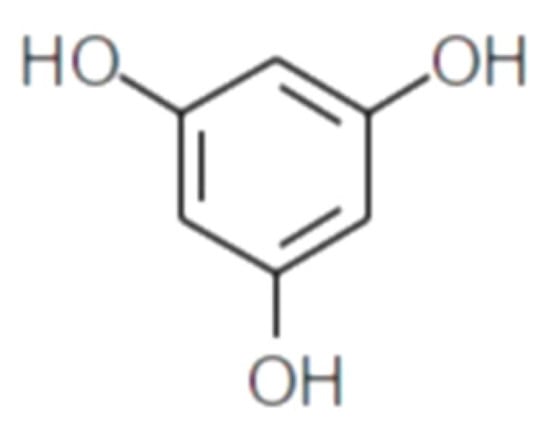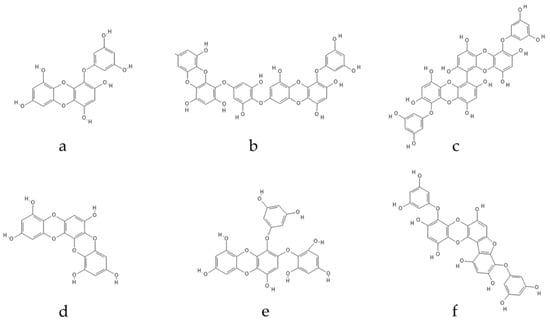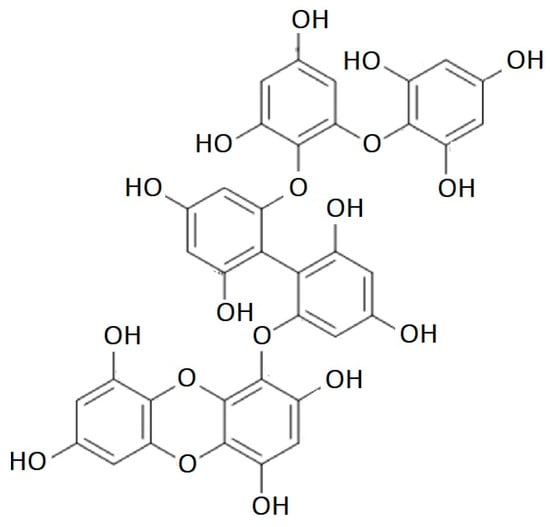Your browser does not fully support modern features. Please upgrade for a smoother experience.
Please note this is an old version of this entry, which may differ significantly from the current revision.
Subjects:
Neurosciences
Polyphenols are beneficial natural compounds with antioxidant properties that have recently gain a lot of interest for their potential therapeutic applications. Marine polyphenols derived from marine macroalgae have been discovered to possess interesting antioxidant properties; therefore, these compounds can be included in several areas of drug development.
- marine polyphenols
- seaweeds
- antioxidant activity
- neurodegenerative diseases
1. Introduction
The advantages of marine macroalgae (or seaweeds) to human wellbeing are well known [1,2,3,4]. Numerous bioactive molecules found in seaweeds may have health advantages against a range of diseases and conditions, including cancer, inflammation, microbes, and viruses [5,6,7,8,9,10,11,12]. The potential of seaweed bioactive compounds to act as a natural resource with remarkable neuroprotective properties can be based on abundant published results from recent clinical and preclinical studies. Numerous studies have documented seaweed bioactive compounds exhibiting therapeutic activities [13,14,15,16,17,18,19].
Seaweed biomass is a promising, renewable, and cost-effective [20,21,22] resource of high-value bioactive compounds that have been highly invested in within the food, pharmaceutical, and cosmetic industries [23,24,25,26,27,28,29].
Marine polyphenols have been discovered to be powerful antioxidant compounds; therefore, they can play a crucial role in the development of natural and innovative neuroprotective drugs.
Neuroprotection refers to methods and mechanisms that protect neuronal cells against injury, dysfunction, deterioration, and cell death in the central nervous system (CNS) [30]. These compounds may slow the progression and limit neuronal cell loss; therefore, the use of those would improve quality of life for patients affected with neurodegenerative diseases.
The progressive loss of specifically vulnerable groups of neurons characterizes neurodegenerative disorders, which are frequently (though not always) accompanied by neurodegenerative symptoms. Neurodegenerative diseases can be categorized according to their primary clinical characteristics, such as dementia, parkinsonism, or motor neuron disease; anatomical distribution of the disease, such as frontotemporal degenerations, extrapyramidal disorders, or spinocerebellar degenerations; or principal molecular abnormality [31]. Although the exact pathophysiology of neurodegenerative diseases is still unclear, common factors contribute to the disease progression: increased oxidative stress, neuroinflammation, misfolded proteins, dysfunctional mitochondria, and impaired proteostasis [32].
2. Marine Polyphenols Involved in Neuroprotective Activity
2.1. Seaweed Polyphenols
Polyphenolic secondary metabolites comprise a large collection of chemical compounds found in terrestrial plants [58,59] and seaweeds [60,61]. Tannins, a prevalent group of phenolic metabolites, contain numerous hydroxyl groups and can be classified into three groups. Condensed tannins, which are based on flavonoids, are found predominantly in woody plants, as well as in red wine and tea [62]. Hydrolysable tannins, formed by polyhydric alcohol, where hydroxyl groups are partly or etherified with gallic acid or related compounds, are found in some green algae and are broadly distributed in angiosperms [63]. Phlorotannins, one of several algal polyphenol’s groups, are of great pharmacological significance. They are composed of many phloroglucinol (1,3,5-trihydroxybenzene) (Figure 1) molecules that are linked together in various ways (Figure 2) [64].

Figure 1. Phloroglucinol (1,3,5-trihydroxybenzene) structure.

Figure 2. Eckol-class compounds: (a) eckol; (b) dieckol; (c) 6,6-bieckol; (d) dioxinodehydroeckol; (e) 2-phloroeckol; (f) phlorofucofuroeckol.
Phlorotannins can be split into six distinct groups based on the type of structural connections between phloroglucinol units and the quantity of hydroxyl groups present: phlorethols and fuhalols (phlorotannins with an ether linkage), fucols (which present a phenyl linkage), fucophlorethols (with an ether and phenyl linkage), eckols (with a dibenzodioxin linkage), and carmalols [65]. In the event of cellular damage, these substances are produced via the acetate–malonate pathway [66].
Phlorotannins, a type of polyphenolic compound, are found exclusively in brown algae, and their quantity can vary among species, depending on factors such as algae size, age, tissue type, salinity, season, nutrient levels, intensity of herbivory, light intensity, and water temperature [67]. Similar to other polyphenols, phlorotannins have several remarkable properties relevant to biological systems, including antioxidant [68], anti-inflammatory [69,70], antimicrobial [71], anticancer [72], and antidiabetic [73] activities. Furthermore, phlorotannins play a significant role in neuroprotection via different mechanisms of action.
Although their molecular sizes seem to be important for producing robust interactions with enzymes, variations in the positions and numbers of OH groups and O-bridge linkages may play an even more important role in promoting inhibitory activity. Additionally, phlorotannins can form enzyme–inhibitor complexes by associating with proteins [74].
Reports of different types of phlorotannins in brown seaweeds confirm that the role of these compounds in nature is to protect algae against environmental stressors and predators, although numerous phlorotannins from marine brown algae are known to be an abundant source of nutritious food because of their benefits for health [61,75].
Ecklonia cava is a type of marine brown algae that contains a greater abundance of phenolic compounds than other brown algae [76]. Numerous phlorotannins have been isolated from brown seaweeds such as E. cava, Ecklonia kurome, Ecklonia bicyclis, and Hizikia fusiformis, and have been found to possess potent antioxidant properties, protecting cells against hydrogen peroxide-induced damage [77,78,79]. Among these phlorotannins, eckol, phlorofucofuroeckol A, dieckol, and 8,8′-bieckol significantly inhibited phospholipid peroxidation at a concentration of 1 M in a liposome system, as well as exhibited effective scavenging activities against superoxide and DPPH (2,2-diphenyl-1-picrylhydrazyl) radicals when compared to ascorbic acid and α-tocopherol [80].
2.2. Mechanisms of Action of Antioxidant Seaweed Polyphenols
ChE inhibitors are a successful approach for treating the symptoms of neurodegenerative disorders, even though various strategies can be used to stop the progression of neurodegeneration. Phlorotannins from Ecklonia maxima were isolated by Kannan et al. [81], and the results showed that they had AChE inhibitory action. Dibenzo 1,4-dioxine-2,4,7,9-tetraol and eckol were found to be more effective AChE inhibitors than phloroglucinol. This is likely because they have larger molecules and more hydroxyl groups than phloroglucinol, which can modulate their interactions with AChE and subsequently block it (Figure 3). These findings highlight the potential uses of E. maxima as a beneficial ingredient that could be used as additives to foods to act as neuroprotective foods [81].

Figure 3. Illustration showing a potential way in which polyphenols may affect neurotransmission. The process of ACh formation occurs briefly before it is broken down by AChE, ultimately leading to the transmission of neurotransmitters to postsynaptic neurons. The inhibition of these enzymes occurs when polyphenols bind to the active sites of AChE or BChE.
Ecklonia stolonifera is a perennial brown alga that is extensively dispersed throughout Korea. Eckol, dieckol, 2-phloroeckol, and 7-phloroeckol were isolated from this alga and showed a selective dose-dependent inhibitory activity against AChE; eckstolonol and phlorofucofurofuroeckol A inhibited both AChE and BuChE. Phloroglucinol and triphlorethol A, a phloroglucinol opened-chain trimer, did not, however, inhibit ChE at the measured concentrations. These results demonstrated that phlorotannins possess structural features that prohibit the binding of substrates to ChE, but they also implied that the degree of polymerization and closed-ring structure must be crucial elements in phlorotannins’ capacity to inhibit ChE [82].
Jung et al. [82] evaluated dieckol isolated from E. cava’s neuroprotective benefits by looking at its anti-inflammatory properties. The results showed that dieckol down-regulated nuclear factor b (NF-kB), activated p38 kinase, and/or inhibited ROS signal in microglial cells to significantly inhibit the expression and release of cytokines and mediators that promote inflammation, such as ·NO, PGE2, IL-1β, and TNF-α. The management of reactive stress and neuroinflammation brought on by microglia, which are essential for the beginning of neurodegenerative processes, may therefore be aided by dieckol.
In another work, Yoon et al. [83] isolated phloroglucinol, 6,6′-bieckol and diphlorethohydroxycarmalol (DPHC) from Ishige okamurae, a brown edible alga found throughout Korean upper and middle intertidal costal zones. They tested the compound’s ability to inhibit ChE, showing that 6,6′-bieckol and DPHC had strong effects on AChE and modest effects on BuChE, respectively.
Phlorotannins have been shown to have a neuroprotective effect in previous studies through a number of mechanisms, including inhibition of AChE, BuChE, monoamine oxidase, and inhibition of Aβ-precursor protein enzyme 1 (BACE-1) activity [84]. Additionally, phlorotannins have the capacity to modify neuronal receptors and control signalling cascades involved in neuroinflammation, oxidative stress, and neuronal cell death [84]. Although Lee et al. [85] demonstrated that eckol and dieckol were ascribed anti-neuroinflammatory properties in Aβ25–35-treated neuronal PC12 cells, earlier studies showed that eckol, dieckol, and phlorofucofuroeckol A (PFFA) decreased Aβ-induced cell death, inhibited intracellular ROS generation, and increased calcium generation [86].
The most common neurodegenerative condition that causes dementia—a condition marked by increasing memory loss and cognitive decline—in the aging population is AD. The clinical symptoms of AD include the build-up of intracellular neurofibrillary tangles and extracellular A plaques in the brain [87]. Aβ plaques, soluble Aβ oligomers, and protofibrillar forms impair synaptic signalling at neural junctions, interfering with normal neuronal cell function. Their accumulation causes neuronal toxicity [88].
The destruction of Aβ plaques may promote proper neuronal cell activity. Amyloid precursor protein (APP) is first broken down by β-secretase into soluble β-APP fragments (sAPPβ) and the C-terminal β fragment (CTFβ, C99), and then C99 is further broken down by γ-secretase into the APP intracellular domain (AICD) and Aβ. This process is known as the amyloidogenic pathway. Additionally, a number of Aβ peptides form oligomeric clusters and stress neuronal cells via oxidative stress [89].
Phlorotannins disrupt the amyloidogenic pathway in a variety of ways, decreasing the production of Aβ peptides and lowering the risk of oxidative stress [90]. Recently, Shrestha et al. [91] reported the neuroprotective effects of dibenzodioxin-fucodiphloroethol (Figure 4) that inhibited its neurotoxicity and aggregation of Aβ, providing evidence that phlorotannins have a neuroprotective function through a variety of pathways.

Figure 4. Dibenzodioxin-fucodiphloroethol structure.
AChE also engages in non-cholinergic mechanisms, such as accelerating the formation of Aβ plaques through conformational changes in Aβ and raising Aβ toxicity by Aβ-AChE complexes, and it is essential for cholinergic neurotransmission. Therefore, by preventing the accumulation of extracellular Aβ plaques, multi-enzyme target inhibition against AChE may offer a possible therapeutic approach for AD.
This entry is adapted from the peer-reviewed paper 10.3390/md21050261
This entry is offline, you can click here to edit this entry!
